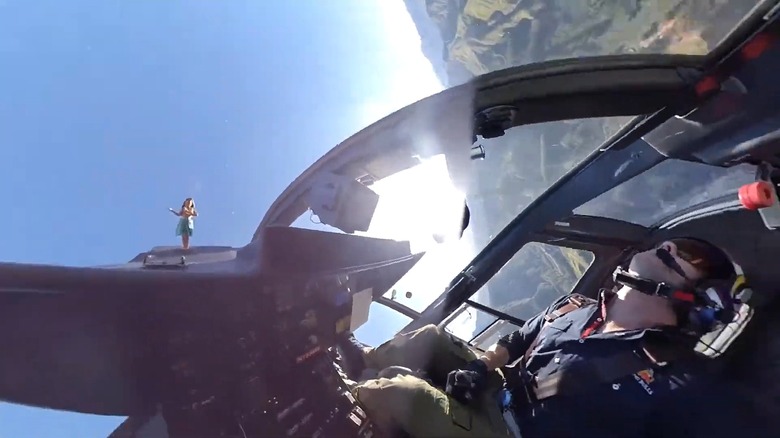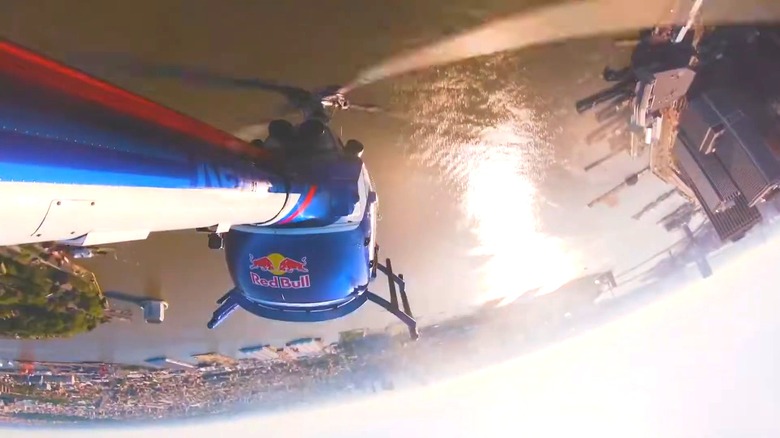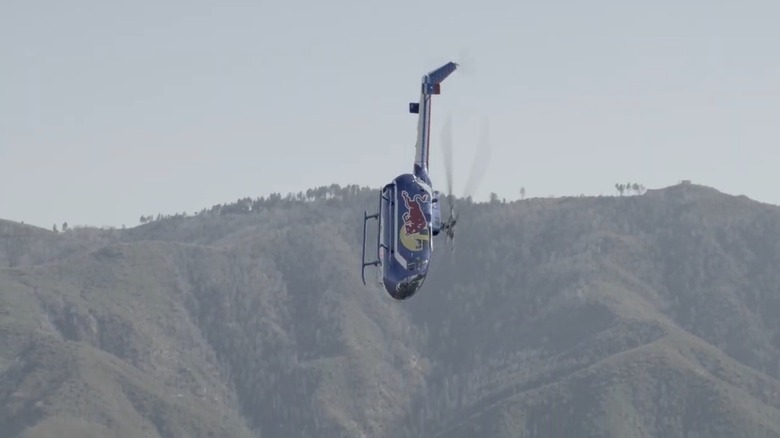Can A Helicopter Do A Barrel Roll?
There are some remarkably maneuverable modern aircraft out there that continue to push beyond traditional boundaries. Although, it's not just the most agile fighter jets in the world that can pull off impressive aerial stunts. For instance, you wouldn't believe what some rotorcrafts are capable of, like the Red Bull helicopter which performs extraordinary aerobatics, thrilling audiences everywhere. But how about a barrel roll, is this something that's possible in a helicopter?
Well, sort of. Due to a helicopters unique design, it isn't able to perform a strict aileron roll, which is when an aircraft begins to twist upside down while climbing and rights itself on a decent (essentially flying in the shape of an inverted crescent). And it can't complete a full barrel roll, which includes a more exaggerated climb and descent while twisting, (imagine an aircraft following the shape of a massive tube while inverting). Even so, Red Bull's MBB BO-105C helicopters are capable of an aerial stunt somewhere in between an aileron and barrel roll, but it is no less spectacular.
So, can all helicopters can do these types of stunts?
Not all rotorcraft are capable of pulling off maneuvers like Red Bull's MBB BO-105C can. There are specific factors vital to the success of completing a barrel roll–like aerial feat, such as a dry sump oil system. A dry sump configuration includes an oil tank outside of the engine itself, often fixed above the powerplant, so it remains cooler and leverages the force of gravity to aid in oil distribution. Unlike a wet sump system, which only has one oil pump, a dry sump setup includes an additional scavenge pump, which pushes the oil out of the engine and returns it to the tank. Put simply, a helicopter doing aerial stunts is going to pull some significant G-forces, which could starve the engine of oil without the advantages of a dry sump system.
There are also several different types of rotor systems, but one in particular is most useful for aerial acrobatics, a rigid rotor system. This configuration is more basic than some others, such as the K-MAX helicopters' intermeshing rotor system, but provides enhanced agility, only allowing the blades to alter pitch and flex when needed.
Another significant component vital to dazzling air show crowds with inverted rotorcraft stunts, is a unique fuel system. Many helicopters have gravity fed fuel configurations, which work fine for normal flying. However, imagine an aircraft using the force of gravity to feed its engine fuel then goes upside down. For helicopters like the Red Bull MBB BO-105Cs, the fuel system requires a pump, so that no matter what orientation the aircraft is during stunts, the engine won't be starved for fuel.
Some facts about the Flying Bulls BO-105C helicopter you might not know
There are two BO-105C helicopters in Red Bull's Flying Bulls team and they were originally built back in 1974. Well before these aircraft were carrying-out death-defying feats, they served as police helicopters. Not only do these models excel with aerial stunts, their maneuverability is an asset to law enforcement, militaries, and rescue operations. Considered the first ever light helicopter, the German BO-105C's revolutionary hinge-less rotor configuration and glass-reinforced plastic constructed blades, are what allow it to still be the only helicopter capable of airplane maneuvers.
In terms of performance, the BO-105C is equipped with two Rolls-Royce 250-C20B engines, each outputting 420 horsepower. The Flying Bulls are capable of a maximum speed of 167 miles per hour, but cruise at around 136 miles per hour. While certainly impressive, these figures don't achieve the performance levels of the fastest military helicopters. However, the Red Bull BO-105Cs are capable of taking off with up to 5,291 pounds of weight, and can reach a ceiling of around 17,001 feet. Not bad for a 50-year-old helicopter.


